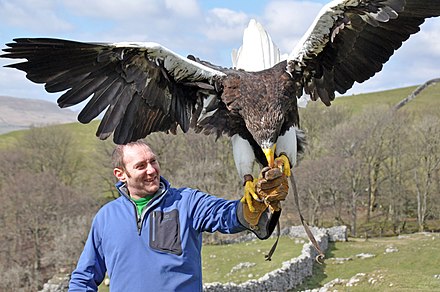Steller’s Sea Eagles (Haliaeetus pelagicus) are known for their impressive flying abilities, and their migration patterns are a fascinating aspect of their behavior. These majestic birds typically depart their breeding grounds between late March and late April, with adults leaving before the immatures.
Timing of Steller’s Sea Eagle Migration
Steller’s Sea Eagles typically depart their breeding grounds in the far eastern regions of Russia, the Korean peninsula, and northern Japan between late March and late April. The adults tend to leave before the immature birds, with the migration following the coastlines.
| Migration Period | Departure Time |
|---|---|
| Late March to Late April | Adults depart before immatures |
During their migration, Steller’s Sea Eagles usually fly singly, with migrants maintaining a distance of 100-200 m (330-660 ft) apart from each other. They are known to communicate using a deep, barking call similar to that of the White-tailed Eagle, as well as a deep, aggressive cry during interactions.
Feeding Habits and Hunting Techniques
 Image source: stellers sea eagle
Image source: stellers sea eagle
Steller’s Sea Eagles are primarily fish-eaters, with a diet that consists mainly of salmon and trout. They are known to hunt from a perch in a tree or on a rocky ledge, located 5-30 m (16-98 ft) above the water. These eagles have also been observed hunting on the wing, circling 6-7 m (20-23 ft) above the water to catch passing fish.
During the winter months, when salmon and trout are dying after their summer spawning, Steller’s Sea Eagles may form feeding groups with smaller Golden Eagles and White-tailed Eagles to take advantage of the abundant food source.
Threats and Conservation Status
Steller’s Sea Eagles are currently classified as Vulnerable on the IUCN Red List, with a total population size of around 4,600-5,100 individuals, including around 1,830-1,900 breeding pairs. The main threats to these rare sea eagles include habitat alteration, industrial pollution, overfishing, persecution, and global climate change, which can cause flooding and affect their ability to capture fish essential to their nestlings’ survival.
Vagrancy and Sightings Outside of Normal Range
One notable example of Steller’s Sea Eagle vagrancy is a bird that has been moving around North America since August 2020. This individual was first spotted near Denali National Park in Alaska and has subsequently been confirmed in various locations in Texas, New Brunswick, Quebec, Nova Scotia, Massachusetts, Maine, and even Newfoundland. This eagle has been documented flying great distances, sometimes over 2,500 miles apart, and is believed to be the same bird based on distinctive markings and patterns.
In conclusion, Steller’s Sea Eagles are impressive birds of prey known for their migratory patterns and hunting techniques. These eagles typically depart their breeding grounds between late March and late April, with adults leaving before immatures. They face various threats, including habitat alteration, pollution, overfishing, and climate change, and are classified as Vulnerable on the IUCN Red List. Instances of vagrancy, such as the Steller’s Sea Eagle sighted in North America, have also been documented, highlighting the adaptability and resilience of these magnificent birds.
References:
– https://www.audubon.org/news/inside-amazing-cross-continent-saga-stellers-sea-eagle
– https://animalia.bio/stellers-sea-eagle
– https://animals.sandiegozoo.org/animals/stellers-sea-eagle
– https://en.wikipedia.org/wiki/Steller%27s_sea_eagle
– https://maineaudubon.org/news/rba-stse-2023/

